The sound of disturbed driveway gravel accompanied by a throbbing eight-cylinder exhaust burble could only mean one thing – the Mercedes-AMG GT 63 4MATIC+ Premium Plus had arrived for testing. New-car tingle never gets old. After accepting the key fob, I poured myself into the car as gracefully as possible and settled in the Nappa-leather-covered AMG sports seat.
It had been a while since I was last expected to drop so low into the cabin of a Mercedes-Benz. On that occasion, back in 2007, it was via the gullwing door of the SLS AMG for a series of exhilarating laps around the famous Kyalami race circuit. Seated pretty much on the rear axle, staring out down an imposingly long and contoured bonnet, revelling in the 6.2-litre V8’s thrust and thunder you couldn’t help but feel the brand’s premier competition pedigree shining through. That’s something that wasn’t always apparent in the marque’s lesser offerings at the time and it felt truly special.
Much has changed since then – even an A-Class feels relatively taut and sporty now. Of late, my super-sportscar fixes have come mostly from Porsches, McLarens and the odd Aston Martin. Somehow, an opportunity to drive the 2014 SLS-replacing GT escaped me, so I was definitely up for a range-topping Mercedes-Benz experience.

Wide, yet tapered at both ends with muscular haunches, sleek fastback glasshouse and curvaceous, crease-free surfacing, I’m probably not alone in finding the GT hugely desirable, at least from most angles

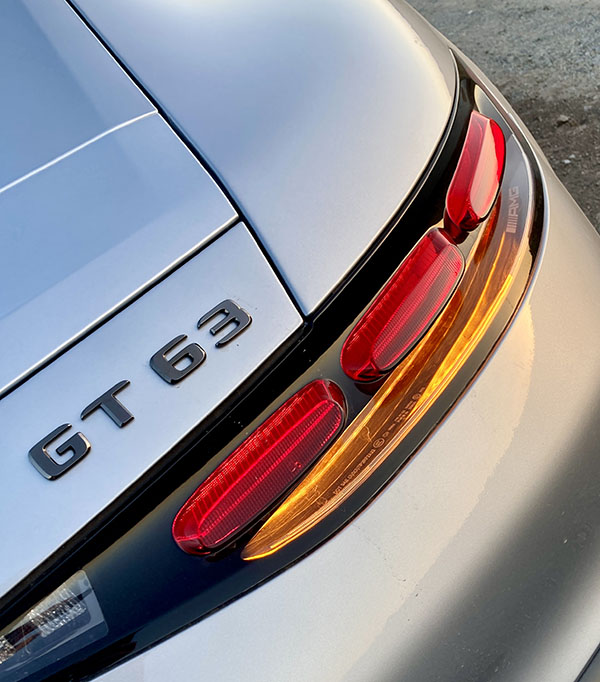
For this genre of car, good looks are essential. Wide, yet tapered at both ends with muscular haunches (wrapped tightly around 21in forged alloys), sleek fastback glasshouse and curvaceous, crease-free surfacing, I’m probably not alone in finding the GT hugely desirable, at least from most angles. Subjective preference aside, you can’t deny the obvious; this car has a very large face. As with direct front-engined rivals from Aston Martin, it’s all grille up front. Imposing for sure, and at first glance similar to its predecessor. Except it really isn’t. Take a closer look and the proportions are quite different. The old car’s acre of metal between the front wheel arch and the door shut line has been slashed, along with the signature side vents, the origins of which could be traced all the way back to the 1953 W 194 ‘Hobel’ prototype.
The bonnet is shorter and curvier in profile, too. Pop that engine cover and the reason is evident – the ‘hot V’ engine, now no longer a dry-sump unit, and connected directly to the repositioned, new nine-speed transmission, sits visibly higher and further forward. Driving those decisions was Mercedes’ intentional push towards a more practical packaging concept. The upside is a noticeably roomier cabin, with two additional seats in the test unit’s Premium Plus specification. The rearmost pews are strictly for small passengers, but the backrests do fold down should you need to double the already decent amount of luggage space.
Inside, it’s all leather and carbonfibre luxury with a panoramic fixed-glass roof and Burmester surround sound. It’s also a contemporary tech-fest, featuring a multi-themed and configurable instrument display, swipeable control pads, capacitive display buttons, head-up display and large central touchscreen. The MBUX infotainment system controls everything from the 360-degree parking cameras and the three-programme massage seats to the AMG Track Pace that allows you to record telemetry data and videos while driving – which one of those you prefer probably says a bit about your age.
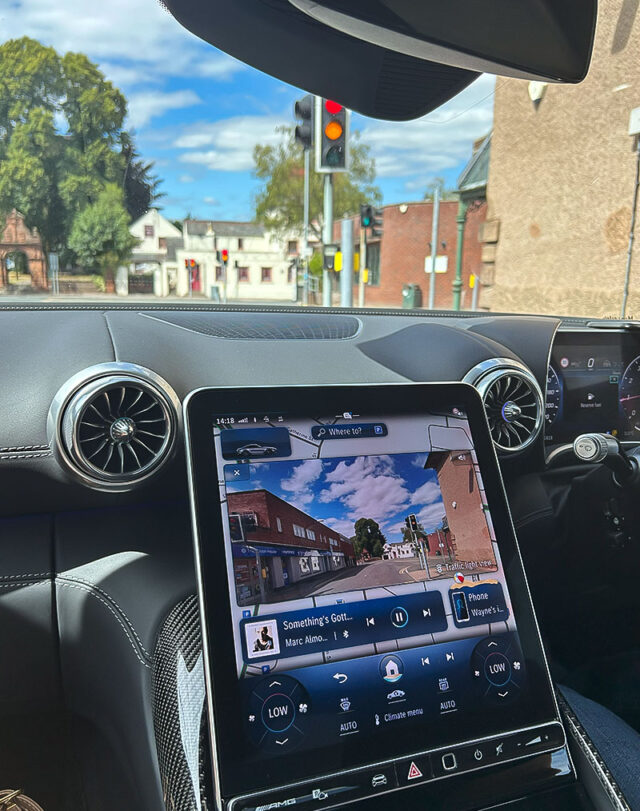
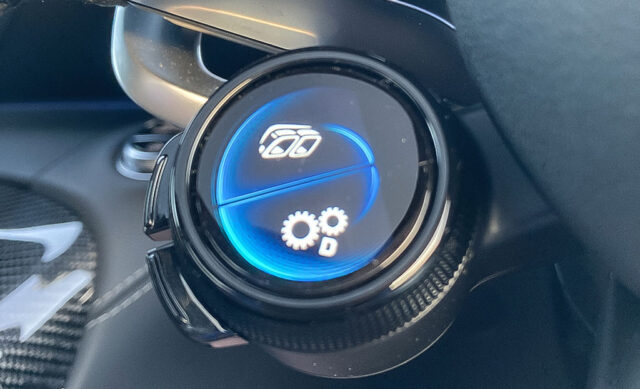
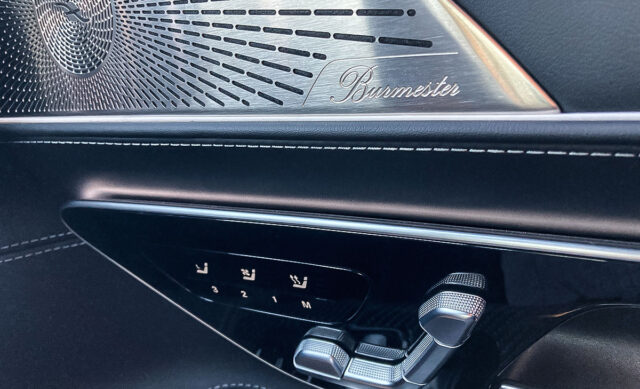
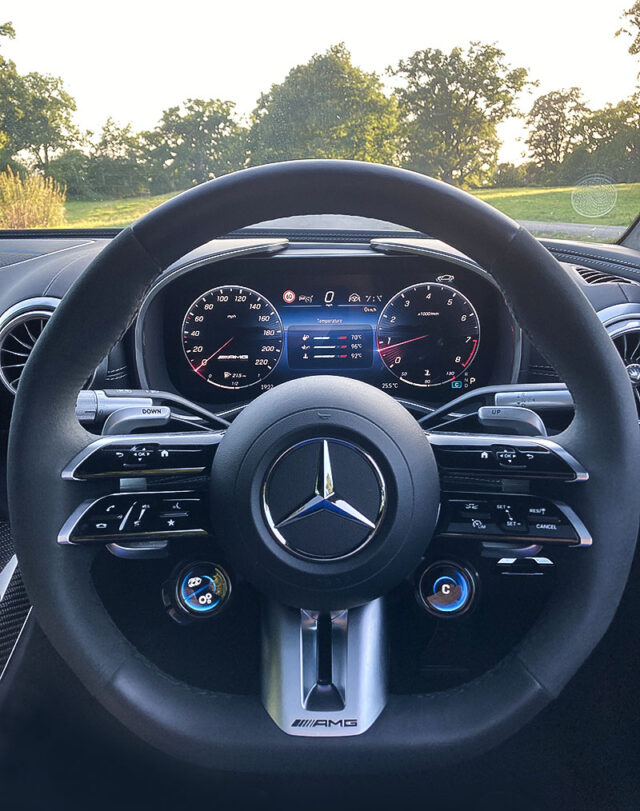
As with pretty much all premium cars these days, the specification is dazzling, with more active safety, parking, comfort and driver aids than you could possibly get to grips with in just a few days. The depth of the technology on offer is impressive. All useful no doubt, but, coming from an older school of thought, I prefer to concentrate on actually driving the thing than deciding which of 64 different mood lighting colours to wash the cabin in.
Thankfully, firing up the V8 won’t set off adjacent car alarms, but it still produces a mental kick. Flick the column-mounted stalk selector down into ‘D’ and ease away with absolutely no drama, bar the quizzing stares of bemused neighbours. Living in rural England, surrounded by hilly, snaking and often pockmarked A-roads has its advantages: they’re a great test of slow-speed dynamics, steering and overall ride quality. Straight out the gate I note the sublime steering – smooth, responsive and ‘connected’, it’s a major positive for me. I’m sure the rear-wheel steering plays a role here, as it works away imperceptibly in the background.
Exiting a 30mph zone and punching the throttle pedal, the 63 goes from sublime to ridiculous. *Insert expletive here* This car is blisteringly fast, courtesy of a bi-turbo 4.0-litre V8 that produces 577bhp and a quick-change artist masquerading as a nine-speed gearbox. Officially, it’ll do 0-60mph in a whisker over three seconds. With up to 800Nm of torque on offer and trick variable all-wheel drive providing relentless grip, the GT is so fast that a full right-foot arch extension on a public road from any gear, at any rolling speed, means you’re effectively never more than two seconds away from serious legal trouble. In reality, this car is frustratingly fast; the burst of adrenaline – aka your speed fix – is over so quickly on public roads that you can’t really enjoy that particular aspect of its character.

However, you can appreciate the body control. Branded AMG Active Ride Control (incorporating a useful 30mm front-axle lift function), it is effectively active adaptive suspension with continuous roll stabilisation. Combined with that aforementioned sweet steering, slinging the GT into a set of corners produces almost zero body roll, enhancing the cornering speed and subsequent enjoyment significantly. It’s a part-throttle canyon carver of note.
Hit the first serious road imperfection, though, and the new car’s increased mass makes itself known. Surprisingly, even minor impacts crash upwards into the cabin. I say surprisingly because Mercedes has worked wonders quelling bodyroll and the general ride comfort is excellent on unblemished roads. However, this is now a two-tonne car, or 1970kg by the EU standard. That represents a 275kg increase over its predecessor. Blame the addition of all-wheel drive and a slew of new tech, but could it also be that the blind-eye approach to untenably heavy battery-powered vehicles is allowing manufacturers to be less concerned about kerbweights across the board?
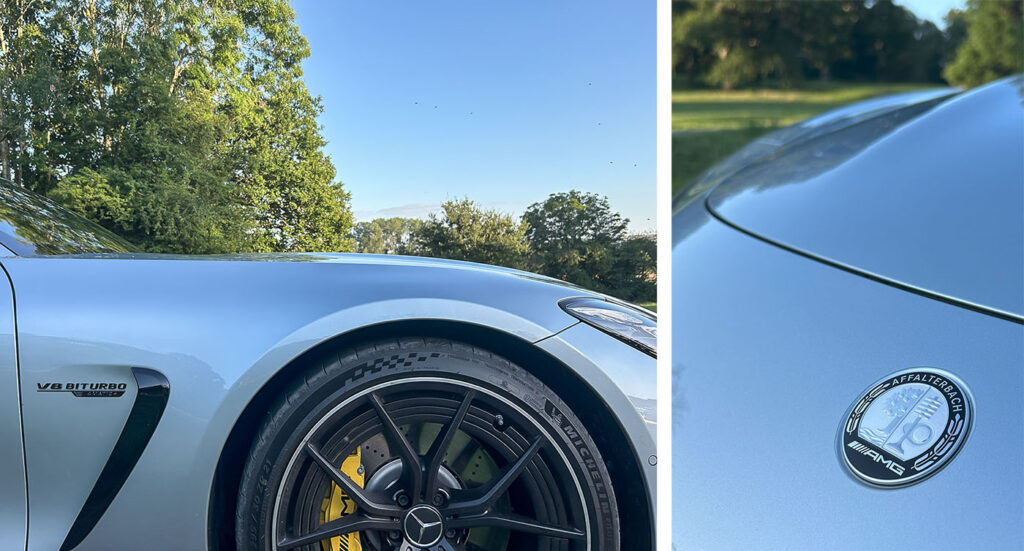
Short of driving the GT 63 on a race track, it’s impossible to get anywhere near its limits – most of the time the engine is running at single digit-percentages of its full performance potential. As an example: using the gear selector paddles between 30mph and 60mph when you have nine ratios and boat loads of torque is completely pointless. And, just how good is the electronic limited-slip rear-axle differential? Without risking a backwards-into-a-hedge moment, I couldn’t really say. Fortunately, it’s a perfectly accomplished cruiser, allowing you to easily tick off a day’s worth of smooth motorway miles in a relaxed, comfortable and luxurious environment.
Intentionally designed for more everyday use, the second-generation Mercedes‑AMG GT 63 finds itself somewhere between a no-compromise super-sports car and a very fast grand tourer. It has the looks, grip and the performance required of the former and the refinement, luxury and relative practicality required of the latter. I reckon if the team from Affalterbach could shave much of the weight gained over the first-gen GT, style it with less ‘mouth’, and make it a little more forgiving on less than perfect roads it’d be pretty much faultless. There would of course still be the small matter of its £165k price tag.





